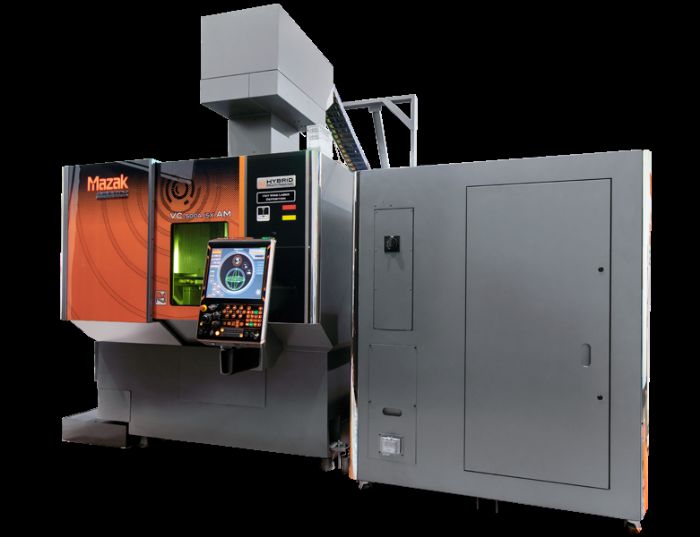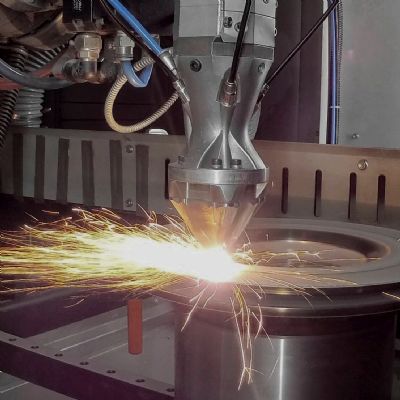Hot-Wire Deposition: Safe, Economical Alternative for Hybrid Manufacturing
June 6, 2023Comments
 Modern hybrid machine tools offer both conventional
machining and advanced additive manufacturing (AM) processes in a single machine
platform, typically using one of two direct-energy deposition AM processes: laser
powder deposition or laser hot-wire deposition (HWD). Mazak officials reports
development of a deposition head by the company that enables creation of complex 3D profiles
via HWD that previously proved difficult and cumbersome, providing HWD with one
more advantage over laser powder deposition.
Modern hybrid machine tools offer both conventional
machining and advanced additive manufacturing (AM) processes in a single machine
platform, typically using one of two direct-energy deposition AM processes: laser
powder deposition or laser hot-wire deposition (HWD). Mazak officials reports
development of a deposition head by the company that enables creation of complex 3D profiles
via HWD that previously proved difficult and cumbersome, providing HWD with one
more advantage over laser powder deposition.
Laser powder deposition processes, using a laser to sinter a blown powdered feedstock to a substrate, have several benefits: fine net resolution, minimal thermal distortion and creation of parts with custom material properties. But, powdered metal alloys present many environmental health and safety concerns, utilization of expensive feedstock utilization is low—around 85 percent—and not all materials are available in powdered analogs.
HWD works by using a high-powered laser to create a melt pool in a substrate. Then, a wire feedstock, preheated using electrical resistance, feeds into the melt pool, flooded by a shielding gas. This process provides good adhesion between layers and creates a homogenous structure in the final part. HWD solves many problems inherent in the powder process, as inexpensive wire feedstock presents few environmental health and safety concerns. Feedstock utilization reaches 99 percent with virtually no material limitations as most alloys are available in a welding-wire analog. And, HWD processes add material at much higher rates than powder. While HWD, unlike powder, cannot mix alloys or produce ultra-fine geometries, machine-tool OEMs still prefer wire AM technology over powder.
While early HWD processes achieved straight linear movement, they faced difficulties in moving the wire in the various directions and planes needed to accurately build 3D profiles due to the introduction of wire to the weld pool at shallow angles. To overcome these movement restrictions, Mazak developed a compact omnidirectional deposition head that reportedly maximizes positioning, flexibility and enables much needed freedom of movement to create complex 3D profiles. Mazak’s new design allows for omnidirectional movement by introducing the wire vertically to the substrate and surrounding the feedstock with a laser beam profile shaped like a donut. This permits a full 5 deg. of freedom in motion.
Mazak showcases its new omnidirectional HWD process on the company’s Hybrid VC-500A/5X AM five-axis vertical machining center. The machine features conventional five-axis milling, drilling and tapping capabilities, and the AM process permits production of near-net shapes and surface coatings, and quick repair operations. The machine can handle a maximum workpiece diameter of 19.68 in. and height of 12 in. X-Y-Z-axis travels: 21.85, 19.88 and 20.08 in., respectively. The machine’s 40-taper spindle has a maximum speed of 12,000 rpm, and a 30-tool changer is standard.
The newly designed omnidirectional 6-kW hot-wire head is expected to achieve deposition rates of 4-7 lbs./hr. Mazak Hot Wire Control Software enables dynamic control of head position, traverse rate, hot wire preheating, laser power and shield gas flow, and provides process monitoring and feedback to the CNC controller. The company reportedly is developing automation technology to minimize preliminary steps and automatically adjust the machine in-process to achieve desired geometries.
View Glossary of Metalforming Terms
See also: Mazak Corp.
Technologies: Additive Manufacturing, Tooling







